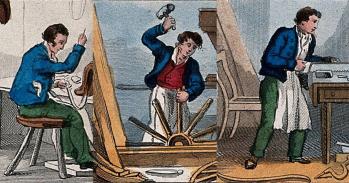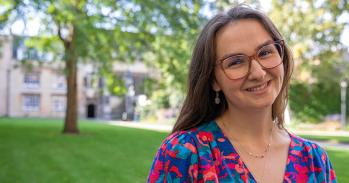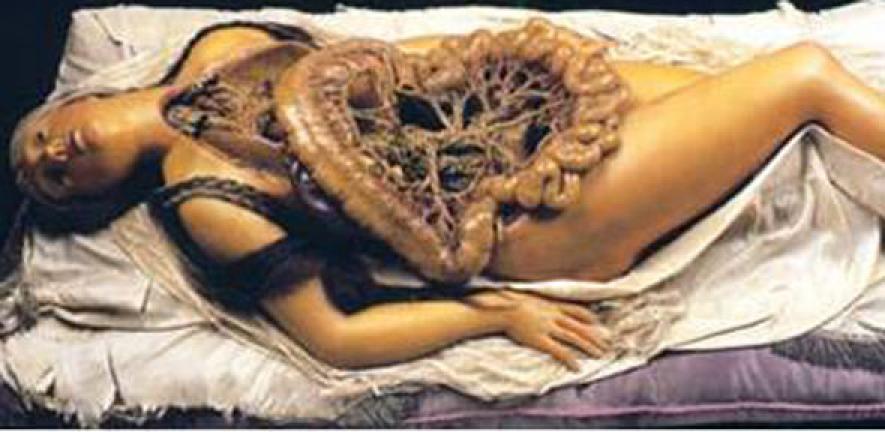
In a talk on 17 February, Margaret Carlyle, a researcher in the Department of History and Philosophy of Science, will explore the fascinating (often gruesome) development in 18th-century Paris of anatomical models and introduce her audience to a remarkable woman who made her name in a field dominated by men.
In a talk on 17 February, Margaret Carlyle, a researcher in the Department of History and Philosophy of Science, will explore the fascinating (often gruesome) development in 18th-century Paris of anatomical models and introduce her audience to a remarkable woman who made her name in a field dominated by men.
It’s believed that Mlle Biheron is the only woman in Europe to establish herself independently as a modeller of wax anatomies.
Margaret Carlyle
Three centuries ago, young men from the British upper classes were sent on the Grand Tour to complete their education and prepare for their futures as cultured members of polite society. Often in the company of tutors, they followed a route that typically took them on a journey across Europe, from Paris to the Mediterranean, where they mingled with other privileged elites, visited sites of cultural and historical importance, and explored natural wonders.
"The Europe of the 18th century– the so-called Age of Enlightenment – is in many ways a watershed in cultural and social history,” said Margaret Carlyle, a Postdoctoral Fellow in the Department of History and Philosophy of Science. “It marks the beginning of modernity in terms of global travel and knowledge exchange, as well as the development of the medical sciences as we know them. The Grand Tour undertaken by privileged young men was part of that bigger desire for novel experiences and broadened perspectives.”
On 17 February, Carlyle will give a talk titled ‘Skeletons in the cabinet and the Grand Tour of anatomy’ that will open a window into her research into Enlightenment anatomy. In particular, she will discuss how an upturn in tourism, fuelled by the acquisition of curious specimens (such as skeletons) contributed to anatomy’s growing authority. She will look at the anatomy cabinet as a public-private space where medical learning was created and deployed, and also discuss the tension between curiosity and voyeurism as the limits of what was acceptable (or not) were increasingly pushed in the interests of knowledge. 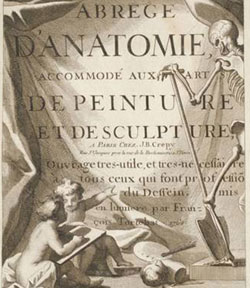
In museums and galleries throughout the capitals of Europe, young men who embarked on the Grand Tour gazed at artistic representations of the human body in paintings, waxworks, and sculptures. Popular were the ‘Skeletons of Malefactors’ on display at the University of Leiden. Wax figures known as Venuses, found in Felice Fontana’s Florentine workshop, are mentioned in many letters and journals recounting travellers’ formative experiences. Grand tourists may well have also visited brothels where, well away from the confines of home, they would have gained (or expanded on) their early sexual experiences.
Research suggests that many young travellers also went to see smaller and less celebrated museums that displayed representations of human anatomy in the shape of skeletons (obtained by rendering down corpses), pickled body parts, and wax models of the body created to show with detailed accuracy the internal organs.
“My research explores the material side of human anatomy and the variety of spaces where new techniques and forms were developed. The ways in which self-proclaimed experts were beginning to develop ingenious ideas for teaching and experimentation are an important part of this story,” said Carlyle. "They can be described as tinkerers or technicians who toiled away in workshops, but they also undertook forms of public outreach that contributed to their growing social authority."
Particularly intriguing is the story of one Mademoiselle Biheron, a middle class Parisian who became famous for her anatomical wax models. Born in 1719, Biheron was a self-trained anatomist and entrepreneur whose museum, or ‘cabinet of curiosities’, in her house near the Sorbonne was an established, if slightly off-beat, stopping point for visitors to the capital. In a craft dominated by men, Mlle Biheron was highly unusual in being a woman.
“At this time, Florence was the centre for wax model making, and Florentine productions were highly sought-after by European aristocrats and royalty. We also know that a couple – the Morandi-Manzolinis – who were making waxworks in Bologna generated a steady flow of tourists. But it’s believed that Mlle Biheron is the only woman in Europe to establish herself independently as a modeller of wax anatomies. This makes her as striking as Mme Tussaud, who became famous in London for her wax models of royalty and celebrities,” said Carlyle.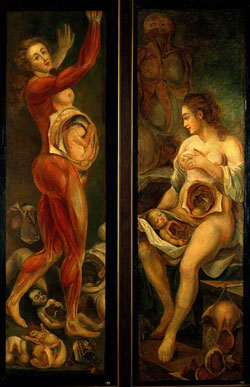
Little is known about Biheron’s background, or how she acquired her fascination for anatomy or skills as a maker of wax works. But archives show that her display of anatomical models (shown both in her home and taken out to exhibit at learned academies) attracted significant numbers of people motivated by a desire to know more about the inner workings of the human body. Her audience included surgeons, academicians, scientists (then known as natural philosophers), artists and members of the public.
Biheron most likely obtained corpses from hospitals and graveyards, which she stored in glassed-in cabinets in her back garden. Dissections enabled her to observe and examine the parts of the body and with this knowledge she created extremely realistic models of the human body. Anatomists affiliated to the Jardin du Roi (King’s Garden) rendered down corpses on the premises by boiling them up in large vats to extract the bones which were then bleached in the sun and re-assembled as skeletons.
The vile stench of putrefaction that accompanied such processes (formaldehyde was not developed until the 19th century) was recorded with revulsion by visitors to another anatomist, Joseph-Guichard Duverney. This was at a time when Parisians would have been familiar with the noxious smells of sewage and tanning that are unfamiliar in modern cities.
“Mlle Biheron’s craftsmanship in making anatomically accurate and life-size models of, for example, a pregnant female was described as an astonishing representation. Each model would have taken months if not years to complete. They were fashioned to have cut-aways to reveal specific systems like the digestive tract and parts that you could lift out to handle,” said Carlyle.
“There’s little evidence suggesting that Mlle Biheron faced prejudice on the grounds that she was female. Indeed, it seems that she was held in high regard by contemporaries precisely because she defied expectations of the fair sex. In the early 1770s, she travelled to London where she exhibited what was described as her 'arsenal of wares' to an undoubtedly curious public, in a room close to her lodgings in the Strand. She was also invited to take her exhibits to the Hermitage to show to Catherine the Great but ill health prevented her from making this journey.”
Correspondence reveals that the French writer and philosopher Denis Diderot sent his daughter Marie-Angélique, in advance of her marriage, to see Mlle Biheron in order that she could gain a clearer idea of the male and female anatomies. “In an era when sex education as we know it was rarely discussed, Diderot was highly enlightened in his attitudes. It remains unclear if other young people were also sent to Mlle Biheron for the same purpose, but we do know that her collection included a wax penis and models showing a foetus developing in the womb,” said Carlyle.
Biheron wasn’t alone in offering a novel experience to Parisians and visitors to the capital. Behind the scenes at a natural history museum owned by the wealthy Montpellier aristocrat, Joseph Bonnier de la Mosson, was a back corridor containing adult and foetal skeletons and other daring specimens of human anatomy. Unlike his multi-faceted collection of botanicals, minerals, shells, and animals – which were exhibited to all – De la Mosson hid his collection of human anatomy behind the scenes and carefully controlled access to it. 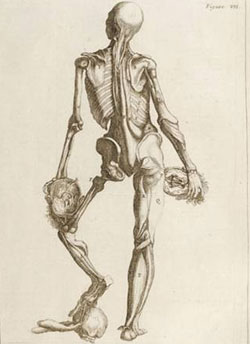
Carlyle said: “This uneasy separation of the public and private demonstrates how the skeleton had become a powerful symbol of the new frontier of anatomy and, indeed, changing attitudes to the human body. The skeleton was mysterious, arousing, and morally compromising, but it was also becoming a domesticated object open to scrutiny and study by tourists and anatomists alike. By the end of the 18th century, the skeleton had made its way into the cabinet of scientific knowledge, and it was there to stay.”
Margaret Carlyle will talk about ‘Skeletons in the cabinet and the Grand Tour of anatomy’ on Monday, 17 February 2014, 1pm-2.15pm, Seminar Room 1, Department of History and Philosophy of Science. All welcome.
Inset images: (top and bottom) Frontispiece and Figure VII of François Tortebat’s 'Abrégé d’anatomie' (1760), Bibliothèque médicale, Poitiers; (middle) Oil painting of dissected women by French anatomist Jacques-Fabien Gautier d'Agoty, Wellcome Collection, http://wellcomeimages.org.
This work is licensed under a Creative Commons Licence. If you use this content on your site please link back to this page.


